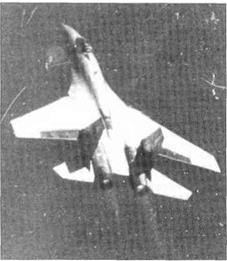Sukhoi P-42
Purpose: To modify a T-10 (Su-27) to set world records.
Design Bureau: P O Sukhoi, Moscow, General Constructor M P Simonov.
According to Simonov, The idea of entering a competition for world records for aircraft of this category was conceived during 1986. We realised that this aircraft was capable of doing many things. We were so confident that, for record setting, we decided not to build a dedicated aircraft but took one of the pre-series ones which had already flown. This then had to be prepared in conformity with the stringent Federation Aeronautique Internationale rules. The aircraft was called the P-42 as a tribute to the turning point in the Stalingrad battle in November 1942, when Soviet aviation had played a large part in crushing the enemy’. The OKB organised a team of design engineers, test pilots and supporting ground staff under Chief Designer Rollan G Mar – tirosov (who later designed Ekranoplans). The modified aircraft was ready in October 1986. In two flights, on 27th October and 15th November 1986 Viktor Pugachev set eight climb-to-altitude records (four absolute and four for aircraft of up to 16 tonnes take-off weight): he reached 3km (9,843ft) in 15.573
seconds and 6km (19,685ft) in 37.05 seconds. On 10th March 1987 and 23rd March 1988 Nikolai Sadovnikov flew the P-42 to 9km (29,528ft) in 44.0 seconds, to 12km (39,370ft) in 55.20 seconds and to 15km (49,213ft) in 70.329 seconds. On 10th June 1987 Sadovni – kov set a world class record by sustaining an altitude of 19,335m (63,435ft) in level flight. Another record set by Pugachev was lifting a load of1 tonne (2,205 Ib) to 15km (49,213ft) in 81.71 seconds.
The aircraft selected was T10-15. It was simplified and its weight reduced until it was able to take off at a weight of 14,100kg (31,08515). With AL-31F engines uprated to 13,600kg (29,982 Ib) this gave a thrust/weight ratio of 1.93, believed to be the highest of any aircraft ever built. Modification to the equipment included removal of the radar and military equipment (including the GSh-301 gun and its ammunition container, wingtip missile launchers and weapon hardpoints) and removal of avionics other than the flight, navigation and communications needed for safe flight. Modifications to the airframe included replacement of the nose radome by a metal fairing, simplification of the wings by installing a fixed leading edge and a fixed structure in place of the flaperons, removal of the
ventral fins and the tops of the fins, replacement of the airbrake by a fairing and simplification of the airbrake supporting structure, removal of the parabrake container, simplification of the variable engine inlets which were locked in their optimum positions, and removal of the mudguard from the nose – wheel. The aircraft was left unpainted.
The P-42 set a total of 27 world records.
|
|











